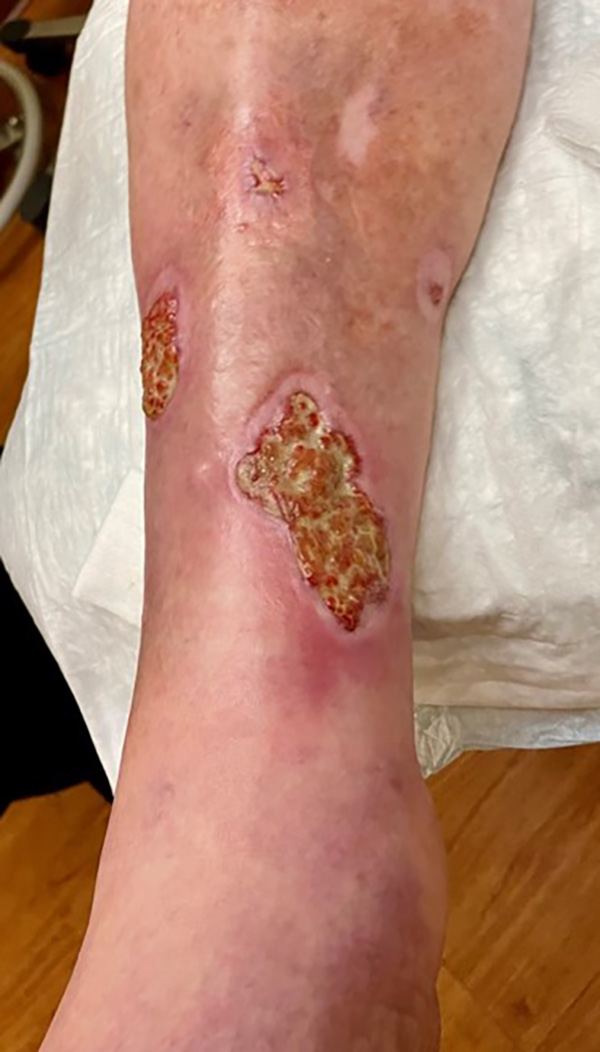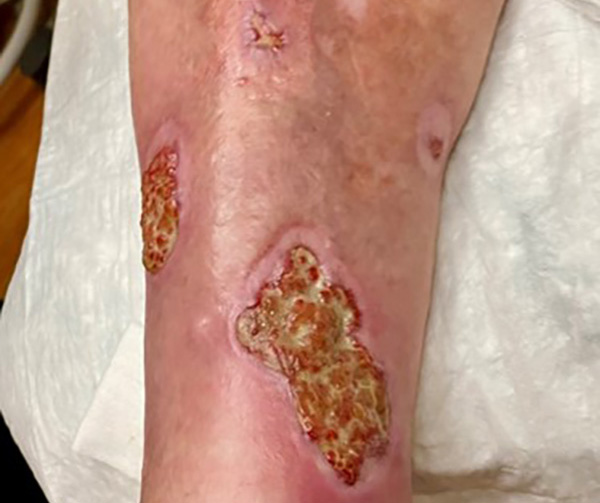This is a story that only happens in the world of chronic wounds. It illustrates why wound care practitioners need to keep asking “What is this wound a symptom OF?” It also illustrates why patients often get worse care as a result of medical specialization because the specialists put on blinders to any medical problem they consider “not in my field.”
Using Occam’s Razor on a Mathematician
This patient was a 67 year old man with well-controlled diabetes and multiple, bilateral, irregularly irregular, painful lesions located on unusual areas like the anterior shin. The wounds had all been made worse by the “serial debridements” performed at another wound center. Since he’d stopped going to that wound center, all the wounds had gotten better. Unfortunately, that part if the history is all I need to make the diagnosis of pyoderma gangrenosum (PG). “My wounds kept getting bigger as a result of the debridements at a wound center,” is a more sensitive test for PG than a biopsy. That’s because, as usual, a biopsy (which was performed at a respected academic dermatology program) was unhelpful and the dermatologist threw up her hands and told him go see a “vascular doctor.”
The day of his initial consult I performed arterial screening and he had a normal skin perfusion pressure (>40 mmHg) with a triphasic pulse volume recording. In other words, he had no peripheral arterial disease. You have only to look at these lesions to see they are NOT Venous. Here’s the most interesting part. He had a colostomy that had been performed for inflammatory bowel disease (IBD), and he had hidranitis supprativa (HS), and scars on his face from cystic acne.
The patient had a PhD in mathematics. I said, “I’m bad at math so I need you to help me do some odds calculations.” The incidence of IBD in the USA is maybe 15:10,000; the incidence of HS is maybe 10:10,000; PG is supposed to be “rare” at 10:1,000,000. That means he had 2 relatively uncommon diseases and one “rare” one. I asked him to calculate the odds that one person had all 3 of those conditions as totally separate medical problems.
The sharpest tool I use on patients with PG is “Occam’s razor.” In other words, the simplest explanation is the best. It’s more likely that he has ONE disease with several different inflammatory manifestations. Somehow, all his problems were related.
PASH Syndrome
I sat down at the computer and did a search for, “pyoderma gangrenosum, hidradentitis and acne” and in about 5 minutes had discovered a genetic syndrome, first identified in 2012. The syndrome has been labled “PASH” for Pyoderma gangrenosum, Acne, and “Supprative Hidranenitis.” (1) In fact, there was a lot of information, (2, 3, 4) There are other PG syndromes that include inflammatory bowel disease and some that include pyogenic arthritis. Exactly where he fits in the syndrome would require genetic testing but it seemed logical and perhaps even obvious that he’s got a genetic syndrome with a name. And that meant someone in the USA was doing research on it.
I called his academic dermatologist and excitedly told her that I thought he had PASH and I intended to start prednisone. She was not at all interested, stuck to her negative biopsy, was unimpressed with my reasoning and disagreed with prednisone. I told her I’d handle it myself. Since he had diabetes, the patient and I agreed that he’d be even more strict than usual in his glucose monitoring and diet and I started 30 mg of prednisone a day for seven days only. At that point, we’d reassess. Meanwhile I checked a G-6-PD level in hopes of starting Dapsone if prednisone helped.
Then I started sending emails. All the papers I found about PASH were written in Europe. I emailed the corresponding authors and I got gracious and helpful emails from authors in 3 different countries! They pointed me to the physician at the NIH who is indeed, focused on PASH syndrome. I emailed the NIH expert, and he responded immediately. He agreed the story was convincing enough for them to want the patient to travel to the NIH for evaluation.
Good News and Bad News
His PG got dramatically better after only one week of prednisone. You can see that in the photos. Even his hidranentiis got dramatically better. There were many wounds, all of which improved, and I could post a lot of before and after photos, but that’s not really the point of this article. He was hopeful, perhaps for the first time in his life. Then, two weeks later, he died of COVID-19. His wife called to tell me the news of his death, but she wanted me to know that after a lifetime of suffering, just having a possible explanation had made a difference in his life.
Here’s the take-home message:
- If you are a wound physician and a patient’s wounds get worse with debridement, for God’s sake, stop doing it.
- Any of this man’s five specialists (and the other wound care practitioner) could have connected the dots if they’d just paid attention to the clinical picture.
- Even many dermatologists can’t make a presumptive diagnosis of PG. I do not understand why one week of prednisone is a terrifying “trial of therapy” for any physician to implement. DO NOT TRUST THE BIOPSY when it comes to PG.
- Most of the authors of published papers and certainly the folks at the NIH are incredibly responsive, so never be afraid to contact people! The correspondence I had with experts from around the world was more encouraging (and certainly more helpful) than the conversations I had with any of the patient’s specialists.
- Finally, the most important thing a wound care clinician can have is intellectual curiosity.
Caroline
- J Am Acad Dermatol. 2012 Mar;66(3):409-15. Pyoderma gangrenosum, acne, and suppurative hidradenitis (PASH)–a new autoinflammatory syndrome distinct from PAPA syndrome.
- Cugno M, Borghi A, Marzano AV. PAPA, PASH and PAPASH syndromes: pathophysiology, presentation and treatment. Am J Clin Dermatol. (2017) 18:555–62. doi: 10.1007/s40257-017-0265-1.
- Marzano AV, Ceccherini I, Gattorno M, Fanoni D, Caroli F, Rusmini M, et al. Association of pyoderma gangrenosum, acne, and suppurative hidradenitis (PASH) shares genetic and cytokine profiles with other autoinflammatory diseases. Medicine (Baltimore). (2014) 93:e187.
- CASE REPORT article, Front. Med., 24 March 2022 Sec. Dermatology; Pyoderma Gangrenosum, Acne, and Hidradenitis Suppurativa Syndrome: A Case Report and Literature Review.
Check out the supplementary material Pyoderma Gangrenosum, Acne, and Hidradenitis Suppurativa Syndrome: A Case Report and Literature Review.

Before one week of Prednisone

After one week of Prednisone

Dr. Fife is a world renowned wound care physician dedicated to improving patient outcomes through quality driven care. Please visit my blog at CarolineFifeMD.com and my Youtube channel at https://www.youtube.com/c/carolinefifemd/videos
The opinions, comments, and content expressed or implied in my statements are solely my own and do not necessarily reflect the position or views of Intellicure or any of the boards on which I serve.




Hi Dr. Fife,
I am impressed with your case presentation. It is a great privilege to have your existence and support in wound care specialty. Thank you very much..
Excellent. MIND over matter. Clinical diagnosis is the result of CURIOSITY. What mind does NOT think, eyes do NOT see and ears do NOT hear.
Excellent and gripping presentation. Thank you. So sorry you lost him.
I’m confused here, please forgive me but. did the patient die and if so what was the cause of death? Im very
very concerned and somewhat afraid because I have this same thing on my left leg ( bottom of calf) with a few smalker ones that all started out as water blisters that came from impossible to cure, uncontrolled severe dry itchy skin that also peeled and flaked off for a good months the blisters popped and becane infected then the circularuon in my legs was so bad i t swelled 3 times the size of my bormal leg became red and heated thus went on for over 6 months after a month i went to my primary care ive been 3 time have been prescribed fliud pills anyubiotuc and 2 dufferent antibiotic creams abd needless to sat the reasin i. Writting is cexause im doing my iwn research and this came up from a picture i took of the main wound that started all this and put it in google lend. I’m not sure if I see any improvement ar sll in those two photos I do have glasses and the light in here is poor but I don’t see anything that
Looks to me like a significant change or healing as you say it does in those 2 picture. If all this that I’ve endured and been prescribed hasn’t helped me un almost 8 months now how is a strmeruod pack to do it esp when it looks to me like it did nothu g for gum yoyr patient either and dare I sat he also passed away. Can you help clear up my confusion and hopefully help me with my ussues as well its affecting my quality if life to sat the lest the pain ugliness and just downright fear it has instulled in me is starti g to take a toll i woukd be grateful as i can possubly be for any of your help i cam send photos and give you the exact names if my scripts and my dr.s practice and name as well if you’d like. I’m deaf in one ear it’s hard to talk in the phone I wear a gearing aid un the other ear and read lips since I was 2 years old im now a 55 yr old female so texting g would be great or my email at first seems like a better idea it is shawnminyard717@gmail.com
Thank you so every much for any help you can give insight alone would be a blessing and Lord willing g lead to healing for me hopefully in the near future thank You again for your time and expertise on the matter God bless and jeep you my dear no matter #1111 #222 #378